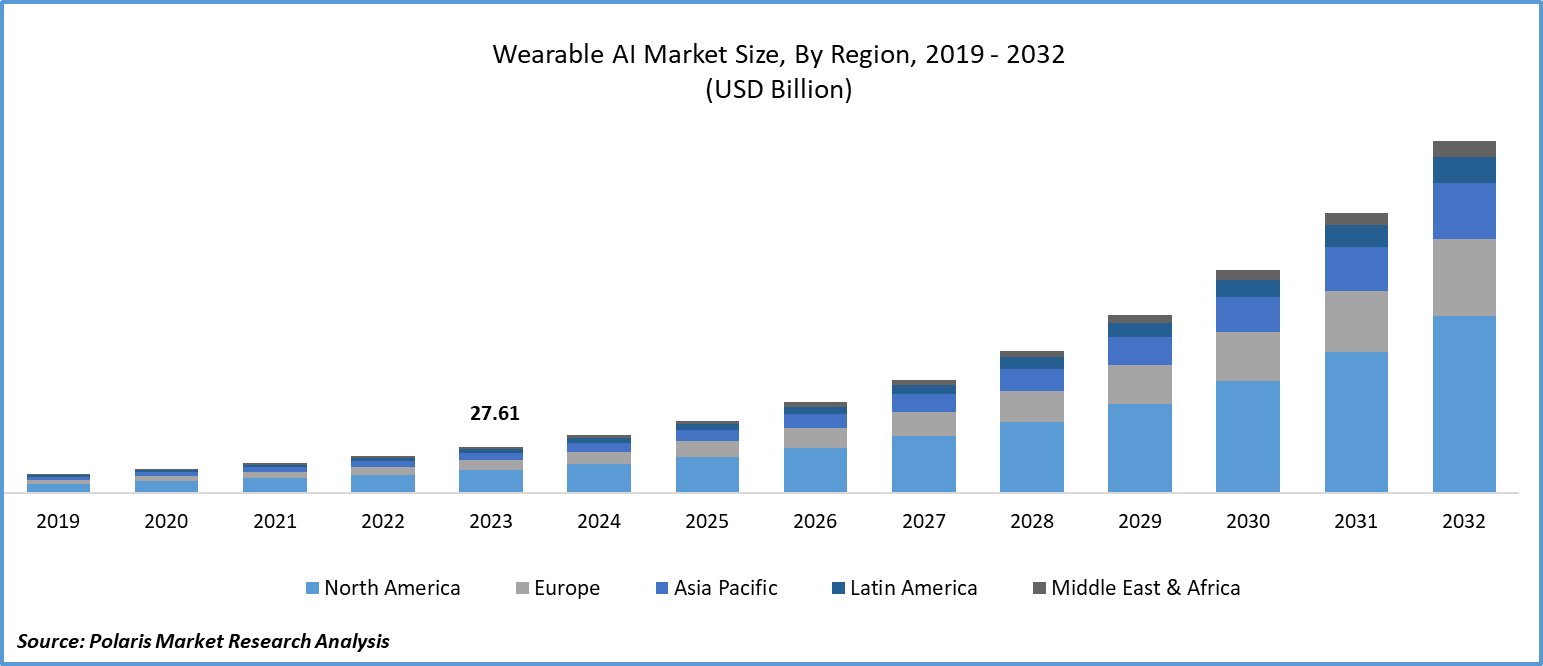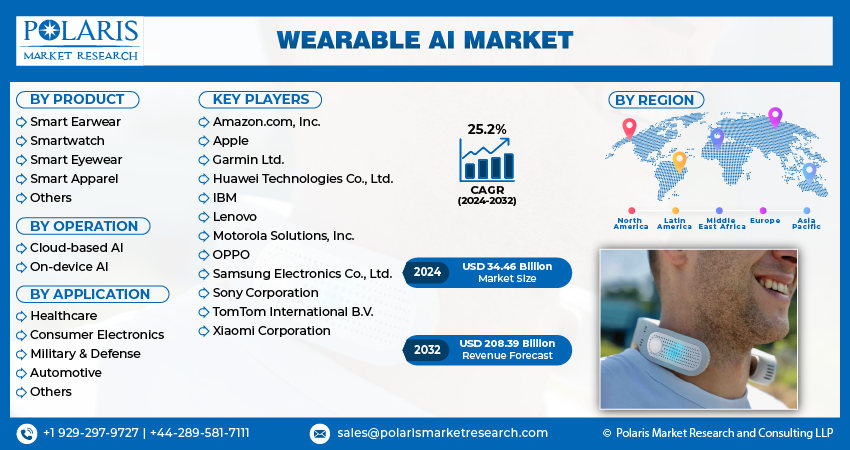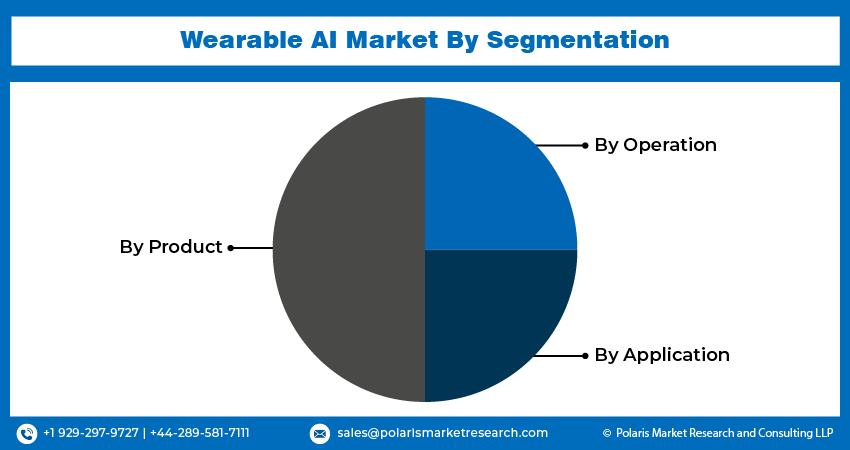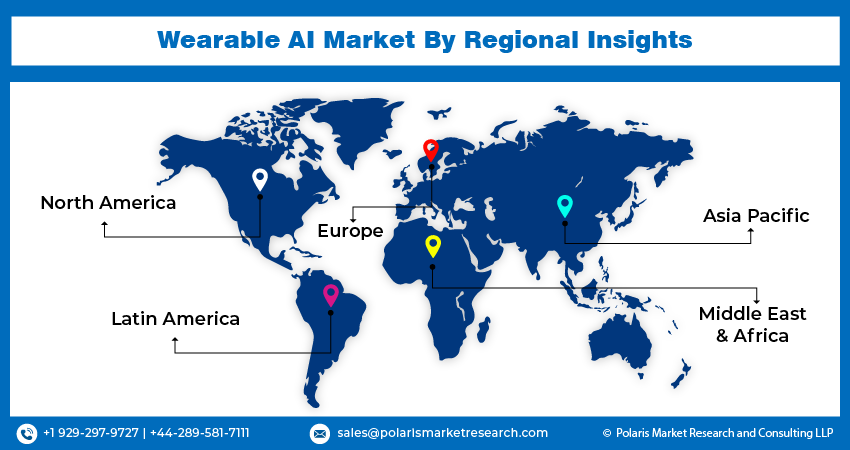
Wearable AI Market Share, Size, Trends, Industry Analysis Report, By Product (Smart Earwear, Smartwatch, Smart Eyewear, Smart Apparel, Others); By Operation; By Application; By Region; Segment Forecast, 2024 - 2032
- Published Date:Apr-2024
- Pages: 118
- Format: PDF
- Report ID: PM4850
- Base Year: 2023
- Historical Data: 2019-2022
Report Outlook
- Wearable AI Market size was valued at USD 27.61 billion in 2023.
- The market is anticipated to grow from USD 34.46 billion in 2024 to USD 208.39 billion by 2032, exhibiting the CAGR of 25.2% during the forecast period.
Market Introduction
A focus on personalized user experiences increasingly drives the wearable AI market. Advancements in AI and machine learning enable wearables to gather and analyze user data effectively. By understanding user behavior and preferences, these devices provide tailored recommendations and insights. Whether for fitness tracking, health monitoring, or virtual assistance, users expect personalized solutions to meet their specific needs and goals. This emphasis on personalization enhances user satisfaction, driving greater engagement and loyalty. Manufacturers are investing in research and development to create innovative wearable AI solutions that deliver customized experiences to each user, catering to the growing demand for personalized interactions.
In addition, companies operating in the market are introducing new products to expand market reach and strengthen their presence.

To Understand More About this Research: Request a Free Sample Report
- For instance, in November 2023, Humane Inc. introduced its AI Pin, marking the debut of a wearable device and software platform designed to maximize artificial intelligence (AI) capabilities. The AI Pin aims to elevate personal consumer technology, granting users unprecedented access to AI in a novel, conversational, and screen-free design.
Integration with smartphones and IoT ecosystems is further driving growth in the wearable AI market. Wearable devices seamlessly connect with smartphones, providing users with easy access to health data and personalized insights through dedicated mobile apps. Moreover, wearables play a vital role in the broader IoT ecosystem, enabling interoperability with other smart devices like smartwatches and fitness trackers. This interconnectedness allows for holistic health management, where data from various sources can be analyzed to provide comprehensive insights. As consumers increasingly embrace connected technologies for health monitoring and lifestyle management, the integration with smartphones and IoT ecosystems fuels innovation and adoption in the wearable AI market.
Industry Growth Drivers
Growing demand for health and fitness monitoring is projected to spur the product demand.
The wearable AI market is growing due to the growing demand for health and fitness monitoring solutions. Consumers increasingly rely on wearable devices with AI capabilities to track vital health metrics like heart rate, sleep patterns, and activity levels in real time. These devices offer personalized insights and recommendations, empowering users to improve their overall well-being. Advancements in sensor technology and connectivity have made wearable AI devices more accessible and user-friendly. With a focus on personal health and wellness, the wearable AI market is poised for substantial growth as consumers seek innovative solutions to monitor and optimize their fitness goals and lifestyle habits.
Rapid Technological Advancements are expected to drive wearable AI market growth.
Rapid technological advancements are driving growth in the wearable AI market. These advancements encompass hardware miniaturization, increased computing power, enhanced sensor capabilities, and advanced machine-learning algorithms. Miniaturization enables sleeker and more comfortable wearable designs, boosting consumer adoption. Improved computing power allows wearables to perform complex tasks and real-time analyses across diverse applications like healthcare, fitness tracking, and augmented reality. Enhanced sensors collect a wider range of data with greater accuracy, providing valuable insights. Advanced machine learning algorithms personalize wearables, adapting to users' preferences over time.

Industry Challenges
Privacy and data security concerns are likely to impede wearable AI market growth.
Privacy and data security concerns present obstacles to the growth of the wearable AI market. These devices collect sensitive user data, including health information and location data, raising fears of breaches and misuse. Dependence on cloud-based platforms further heightens security risks. Additionally, worries about data privacy and ownership deter some users from adopting wearable AI technologies. Manufacturers must implement robust security measures like encryption and user consent mechanisms to address these concerns. Compliance with data protection regulations, such as GDPR, is also crucial for gaining consumer trust.
Report Segmentation
The wearable AI market analysis is primarily segmented based on product, operation, application, and region.
|
By Product |
By Operation |
By Application |
By Region |
|
|
|
|
To Understand the Scope of this Report: Speak to Analyst
By Product Analysis
The smartwatch segment held a significant wearable AI market share in 2023
The smartwatch segment held a significant wearable AI market share in 2023. Smartwatches offer diverse functionalities like fitness tracking and mobile payments. Their compact design enables convenient access to AI-powered features directly from the wrist. Additionally, smartwatches are popular for health and fitness tracking, integrating heart rate monitoring and activity tracking. Seamless integration with smartphones, coupled with stylish designs, broadens their consumer base. Continuous technological advancements, such as improved sensors and longer battery life, further drive adoption and consumer interest in smartwatches.
By Operation Analysis
On-device AI segment held a major wearable AI market share in 2023
The on-device AI segment held a major wearable AI market share in 2023. It enables real-time data processing directly on the device, eliminating the need for constant internet connectivity and reducing latency. This is crucial for applications like health monitoring and gesture recognition, demanding immediate feedback. On-device AI enhances privacy and security by minimizing data transmission over networks, appealing to privacy-conscious consumers and enterprises. It improves user experience by ensuring consistent functionality even in areas with limited connectivity. Additionally, local processing consumes less power, extending battery life. Reduced dependence on cloud services makes wearable devices more versatile and independent, appealing to users seeking standalone functionality.
By Application Analysis
The consumer electronics segment held a significant wearable AI market share in 2023
The consumer electronics segment held a significant wearable AI market share in 2023. High consumer demand for wearable AI devices like smartwatches and fitness trackers, driven by their functionality and convenience, contributes to this dominance. Continuous technological advancements, including miniaturization and improved sensors, enhance the appeal and accessibility of these devices. Health and fitness tracking features, stylish designs, and seamless integration with smartphones further attract consumers. Effective marketing strategies and branding efforts by leading companies in the consumer electronics industry also play a crucial role in driving sales and market share.

Regional Insights
North America region accounted for a significant wearable AI market share in 2023
In 2023, the North American region accounted for a significant wearable AI market share. The region serves as a hub for technological innovation, fostering the development of cutting-edge wearable AI devices. Consumers in North America are early adopters of new technologies, driving widespread adoption of wearable AI devices. Additionally, the region's robust healthcare sector promotes the use of wearable AI devices for health monitoring and remote patient care. A supportive regulatory environment encourages innovation and market growth. Moreover, high disposable income levels enable consumers to invest in premium wearable AI devices. The presence of key market players headquartered in North America further strengthens the region's position in the wearable AI market.
Asia-Pacific is expected to experience significant growth during the forecast period. The region's emerging markets, coupled with rising disposable incomes, create a conducive environment for adoption. Asia-Pacific boasts a thriving technology sector, particularly in countries like China, Japan, and South Korea, which fosters innovation and manufacturing. Rapid urbanization leads to lifestyle changes, driving demand for wearable AI devices for health and fitness tracking. Increasing healthcare expenditures and government initiatives promoting digital healthcare further fuel market growth.

Key Market Players & Competitive Insights
The wearable AI market encompasses various players, and the anticipated entry of newcomers is set to heighten competition. Market leaders consistently innovate their technologies, focusing on efficiency, reliability, and safety to maintain a competitive edge. They prioritize strategic initiatives such as forming alliances, enhancing product portfolios, and engaging in collaborations. Their objective is to surpass rivals in the sector and secure a notable wearable AI market share.
Some of the major players operating in the global wearable AI market include:
- Amazon.com, Inc.
- Apple
- Garmin Ltd.
- Huawei Technologies Co., Ltd.
- IBM
- Lenovo
- Motorola Solutions, Inc.
- OPPO
- Samsung Electronics Co., Ltd.
- Sony Corporation
- TomTom International B.V.
- Xiaomi Corporation
Recent Developments
- In March 2024, Titan collaborated with CueZen to develop impactful products and programs for highly personalized health experiences. This partnership is geared towards elevating consumer engagement and delivering meaningful insights, enhancing the overall consumer experience.
- In September 2023, Apple unveiled its new smartwatch lineup, the Apple Watch Series 9, featuring the innovative S9 SiP for enhanced performance and capabilities. Additionally, it introduces a new double tap gesture, a brighter display, faster on-device Siri functionality, and improved access to health data logging.
- In December 2023, Boat partnered with Reliance Jio to launch the Lunar Pro LTE smartwatch, leveraging Jio's eSIM technology for connectivity. This innovative feature enables users to place calls and send messages directly from the smartwatch, bypassing the requirement for a smartphone.
Report Coverage
The wearable AI market report emphasizes key regions across the globe to provide a better understanding of the product to the users. Also, the report provides market insights into recent developments and trends and analyzes the technologies that are gaining traction around the globe. Furthermore, the report covers an in-depth qualitative analysis pertaining to various paradigm shifts associated with the transformation of these solutions.
The report provides a detailed analysis of the market while focusing on various key aspects such as competitive analysis, products, operations, applications, and their futuristic growth opportunities.
Wearable AI Market Report Scope
|
Report Attributes |
Details |
|
Market size value in 2024 |
USD 34.46 billion |
|
Revenue Forecast in 2032 |
USD 208.39 billion |
|
CAGR |
25.2% from 2024 – 2032 |
|
Base year |
2023 |
|
Historical data |
2019 – 2022 |
|
Forecast period |
2024 – 2032 |
|
Quantitative units |
Revenue in USD billion and CAGR from 2024 to 2032 |
|
Segments Covered |
|
|
Regional scope |
|
|
Competitive Landscape |
|
|
Report Format |
|
|
Customization |
Report customization as per your requirements with respect to countries, regions, and segmentation. |
FAQ's
The global wearable AI market size is expected to reach USD 208.39 billion by 2032
Key players in the market are Amazon.com, Inc., Apple, Garmin Ltd., Huawei Technologies Co., Ltd., IBM, Lenovo, Motorola Solutions, Inc
North America contribute notably towards the global Wearable AI Market
Wearable AI Market exhibiting the CAGR of 25.2% during the forecast period.
The Wearable AI Market report covering key segments are product, operation, application, and region.
